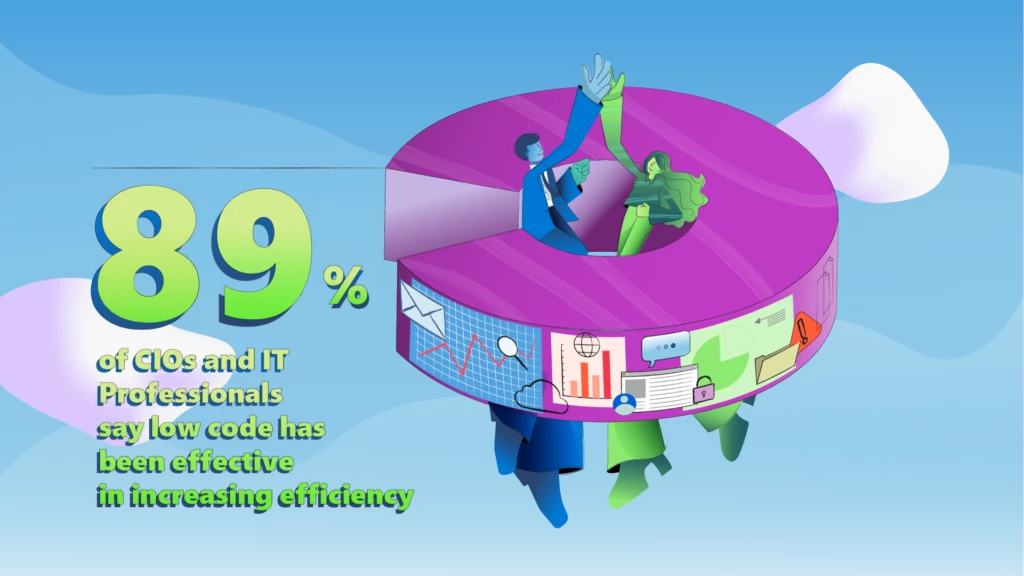
Low-code signals 2023
Low-code: One of the best investments for IT departments in 2023
Under current economic pressures, organizations are being squeezed at all levels, as the International Monetary Fund (IMF) projects slowed global growth in 2023, down to 2.9 percent from 6 percent in 2021.1 IT departments are no exception as they look for creative ways to cut costs.
Concurrently, IT departments are facing a growing application backlog. There are simply not enough developers and technical specialists to meet stakeholder demands. In 2021, IDC predicted that 750 million new apps need to be built by 2025.2 Simply put, the demand for technical solutions is growing at an almost exponential rate, and there are not enough professional developers to meet that demand.
The way forward? Low-code. Edelman Assembly, on behalf of Microsoft, surveyed more than 2,000 IT CIOs and IT pros to understand the benefits they derive from low-code platforms. The research is clear: low-code empowers IT departments to rapidly build technical solutions and streamline data insights all while lowering costs.

Power Platform Adoption Assessment
Receive curated and personalized guidance that fits your specific scenarios.
Accelerate application development
Low-code platforms help drive efficiency gains by accelerating legacy application modernization and expediting development efforts via prebuilt components. In fact, 89 percent of CIOs and IT pros surveyed say low-code is effective in increasing efficiency.

To close the app gap generated by developer shortages and traditional development timelines, low-code helps organizations reduce time to value by extending existing legacy core capabilities, streamlining migration projects, and replacing legacy applications with low-code solutions. These solutions are an incredible boost to application modernization endeavors, as 87 percent of CIOs and IT pros say low-code is very useful in helping their organizations modernize legacy applications.
According to a 2021 Microsoft-commissioned Forrester Consulting Total Economic Impact™ study of Microsoft Power Platform and Microsoft Azure for Corporate IT, professional developer efficiency with low-code platforms significantly increases over time, averaging 62 percent over three years. These efficiency gains are necessary as 45 percent of IT pros say they first adopted low-code platforms to make up for staff shortages.
Additionally, IT pros can expect increasing efficiency gains due to recent announcements of embedded AI in low-code platforms. Features like Copilot in Microsoft Power Apps, Power Automate, and Power Virtual Agents will further streamline solution development with natural language authoring and the ability to converse with an AI assistant. Similar features become increasingly important to organizations adopting low-code platforms, as 87 percent of CIOs and IT pros say increased AI and automation embedded into low-code platforms would help them better use the full set of capabilities, a trend we are seeing across low-code tools.
PricewaterhouseCoopers (PwC) is embracing low-code to accelerate development after building its Cyber Technology Rationalizer solution in six weeks. PwC needed to migrate from its legacy system to improve maintainability, scalability, and versatility with a professional grade solution built for internal and external users.
PwC created a multitenant enterprise decision support website with Microsoft Power Platform. Using the Power Pages Web API management layer, the team found that they could use Microsoft Dataverse with C# plugins to reuse existing work and quickly create a new, low-code solution. Not only did this only take six weeks, but PwC has also achieved 85 percent cost savings and 30 percent time savings since its implementation.
Drive organization-wide cost savings
Reducing costs and building more technical solutions at the same time can sound paradoxical. Application development and maintenance is a costly endeavor, to do more of it should clearly increase costs. So why do 87 percent of CIO and IT pros surveyed say low-code is effective in helping reduce costs?

Power Platform and Azure helped reduce costs by 24 percent due to increased developer efficiency, increased DevOps efficiency, and reduced spending on third-party solutions according to a 2021 Microsoft-commissioned Forrester Consulting Total Economic Impact™ study of Microsoft Power Platform and Azure for Corporate IT.
In addition to reducing direct IT costs, low-code platforms help reduce costs across organizations by building solutions that otherwise would sit in an organization’s application backlog. These solutions drive cost reductions by eliminating manual processes, increasing user productivity, and increasing data-backed decision making.
A great example of the cost savings derived by IT and business departments is EY’s PowerPost app. The company used Microsoft Power Platform to automate the high-frequency, semi-manual General Ledger (GL) posting process used internally by the EY Global Finance team that integrates with its SAP enterprise resource planning (ERP) system.
The GL document posting process was prone to errors due to the data transfer steps between different applications. Sometimes successful posting in SAP could take longer than a day or two. Built in weeks, not months, by EY’s in-house development team with low-code, the PowerPost app reduced document processing lead time by 95 percent, is forecasted to reduce existing costs by 30 percent, and eliminated emails and Excel requirements by 100 percent with the new process.
Streamline data insights to actions
As technology becomes more prevalent in every business process, the volume of data grows at a rampant pace. That mounting data is often duplicated across databases and not properly formatted, making the data inaccessible for decision making. Low-code platforms help break down data siloes by centralizing that data and putting easy to consume data visualizations in users’ hands for cleaner, more actionable data.
Many low-code solutions are built to lift and shift legacy applications and automate manual time-consuming processes. These solutions help break down data siloes, reducing data duplication and centralizing data in a single source of truth. This centralized repository created by low-code platforms is why 86 percent of CIOs and IT pros say low-code helps their organizations generate more accurate insights from their data.

These more accurate insights enable IT pros to build more comprehensive and effective solutions for users. This means reduced re-work and greater adoption of solutions reducing costs and time to market, resulting in decreasing application backlogs for IT departments. The impact of these solutions is evident as 89 percent and 88 percent of CIOs and IT pros respectively say low-code has been effective in generating data-driven insights that they use to better service customers and internal stakeholders.
ÖBB, the Austrian rail operator, saw the benefits of low-code platforms in centralizing data with low-code platforms and is able to offer better service to customers with this data. ÖBB services 477 million passengers annually across Europe. ÖBB needed a way to provide quick, intelligent, automated responses to millions of customer queries—with the ability to hand off to a human agent when necessary.
Using the out-of-the-box AI capabilities in Power Virtual Agents, integrated with their customer relationship management (CRM) system, Power BI, and Power Automate, the company built a chatbot to answer basic customer questions, freeing human agents to concentrate on more complex and high-value interactions.
Moreover, producing detailed internal reports through Microsoft Power BI based on clean, centralized data from Power Virtual Agents bots helped the project team gain unique insights into how customers interact with the bot, including how it transitions them to a live agent. ÖBB used these insights to further refine its bot for improved customer experiences.
How can low-code help your IT department?
For IT departments and organizations looking to reduce costs, reduce their application backlog, and rapidly turn data insights into actions in 2023, low-code should be a key part of your development strategy. To learn how your organization can start, grow, and develop an expert level low-code practice, take the Microsoft Power Platform Adoption Assessment.
This assessment is designed to help you get started quickly by identifying opportunities to optimize and streamline efforts, and sharing best practices on how organizations can better use Microsoft Power Platform to achieve their business objectives.
End notes
1International Monetary Fund, World Economic Outlook.
2IDC, 750 Million New Logical Applications: More Background.




